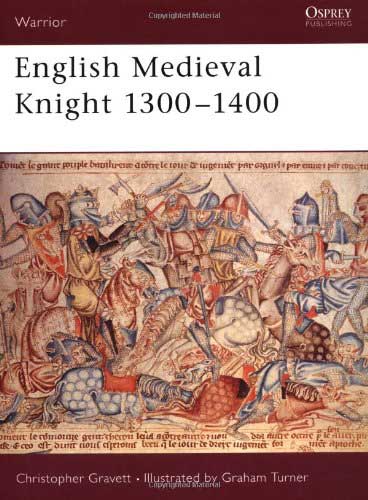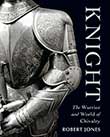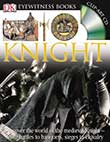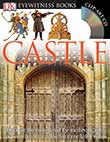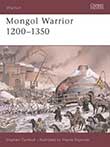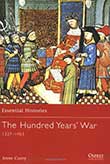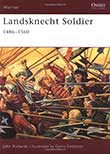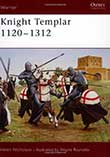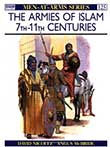

The period is usually considered to open with those migrations of the German Tribes which led to the destruction of the Roman Empire in the West in 375, when the Huns fell upon the Gothic tribes north of the Black Sea and forced the Visigoths over the boundaries of the Roman Empire on the lower Danube.
As you may have guessed, there are an immense number of books on the middle ages. Here are a few. If you don't find what you're looking for here, click one of them and it will take you to Amazon.com and you can do a search from there. Remember, if you link to Amazon through us and order online, we get a small percentage, at no extra cost to you—this will help keep reenactor.Net online!
You might find book reviews on the following books on their pages at Amazon.com. If you would like to review a book, please submit your review to Amazon.com; if you would like to add a few clarifying words to my descriptions, please email me. In many cases, I took the descriptions for these books right from the Amazon.com pages. Really love or hate a book listed here? Want to add your favorites? Thought of a much better way for me to organize these? Please send suggestions, comments and corrections regarding this Area
The 14th-century knight lived in a century of change, in terms of both recruitment methods and the appearance of fighting men. This book describes all aspects of the knight's life, including his training in the castle yard and the hard knocks of tournaments. The knight's daily routine on campaign is explored along with the role of mercenary knights, the motivation of knights in the field and the influence of chivalry. The book is beautifully illustrated with eight colour plates by Graham Turner covering all aspects of knighthood in this period and also includes photographs of rare surviving contemporary pieces of armour.
From a life-long student of the medieval long sword and medieval history comes a comprehensive overview of the Age of the Knights. Jones shows that behind the popular image of the knight in shining armor lies a world that is both more complex and more fascinating. Were knights glory-seeking, bloodthirsty thugs that lay ravage to the Holy Land or simple Christians serving their king? Jones explores the myths and controversies behind their battle-effectiveness and chivalric code. He also examines knighthood as a "career path" and investigates the role of the knight in law and justice. Lavishly illustrated and drawing on rare first-hand accounts, this book reveals the world of the knight in all its tarnished glory.
Detailed photographs trace the origins, heyday, and eventual decline of knighthood, chivalry, and the feudal system. While studying the Middle Ages, you can’t do that without learning more about knights and their chivalry. So obviously, the Eyewitness series has a book specifically dedicated to knighthood. You will learn everything that you wanted to know about the life as a knight with information about the first knights, the Normans, making a knight, iron everywhere, fashion in steel, the armor, the arms, on horseback, the castle, the castle at war, siege warfare, arming for the fight, the enemy, into battle, the castle at peace, the lord of the manor, the lady of the manor, the ideal of chivalry, the tournament, the joust, foot combat, heraldry, hunting and hawking, faith and pilgrimage, the crusades, Knights of Christ, Knights of the Rising Sun, the professionals, the decline of chivalry and much more.
The book is packed with information that will deepen your knowledge on knights. Throught the pages of this book, you will have plenty of photos and illustrations to help you visualize the life of a knight during the Middle Ages. A timeline as well as a glossary complete the book.
DK eyewitness books are some of the greatest non-fiction books around. The distinctive white background and high-quality photography gives this book an edge over any other nonfiction picture book. And—these pictures are real! They're beautiful museum-quality photos of all things related to knights, accompanied by informative captions and text.
Learn about medieval life, knights, armor, etc. If you know someone (young or old) who is fascinated by medieval times and knights, then you must introduce them to this book!
Like Eyewitness Books? This is another nice entry in their series for younger readers. What is a castle? The book describes it thus: "A castle was the fortified private residence of a lord." The lord could be a king or a baron or some lesser noble. It was designed as both a residence AND a stronghold. The book begins by noting that such structures have had a long history (one ancestor goes back to Mycenae in about 1250 B.C.).
The volume moves on to consider the first castles (appearing in the 9th and 10th centuries A.D.). There is discussion of different approaches to building a castle--such as the use of concentric rings to harden the castle against attack. There are also discussions of different styles in castles--from the Loire region in France to Spanish castles, to German castles (take a trip along the Rhine River, and you will see numerous examples) to Japan. There is discussion of how those who wanted to capture a castle would strategize and how castles were structured to defend against such attacks.
The volume considers the different functions of a castle--from defense to kitchens and eating to entertainment.
The volume concludes with a discussion of the decline of castles.
The Mongol warriors are one of the great success stories of world military history. Under the leadership of Genghis Khan and his successors the Mongols conquered much of the known world, fighting in territory ranging from the frozen steppes, the wilderness of Palestine, the jungles of Java and the great rivers of China. Through all this they showed a remarkable ability to adopt, adapt and improve a vast range of military techniques and technology, from siege weapons to naval warfare. This book tells the story of this remarkable military organisation, including details of weaponry, tactics, training and beliefs.
There can be no doubt that military conflict between France and England dominated European history in the fourteenth and fifteenth centuries. This war is of considerable interest both because of its duration and the number of theatres in which it was fought. In this book, Hundred Years’ War expert Dr Anne Curry reveals how the war can reveal much about the changing nature of warfare: the rise of infantry and the demise of the knight; the impact of increased use of gunpowder and the effect of the wars on generations of people around it.
The Landsknecht (meaning 'servant of the country') flourished during a key period for military organisation and practice. In the late 15th century, the Holy Roman Emperor, Maximilian I, recruited thousands of mercenaries from Central and Northern Europe, with the aim of creating a reliable source of men for his armies – and the Landsknecht were born. This book reveals the true-life experiences of the Landsknecht soldier during conflicts such as those of the Italian Wars (1494-1559), using numerous first-hand accounts. It takes a close look at the recruitment, training, daily life and and careers of these formidable soldiers, and examines in detail their clothing, equipment and weaponry. Many fine, contemporary illustrations, some drawn by Landsknecht themselves, accompany the text.
The order of the Temple was a military-religious organisation that was set up to protect pilgrims and settlers in the Holy Land. The Templars believed they were God's warriors fighting on God's behalf and developed a fearsome reputation among the neighbouring Muslim rulers. This book examines the men who joined the order and why they joined it, focusing on those who fought in the Holy Land. Based on contemporary sources it provides an effective insight into the daily lives of the warriors, from their admission ceremony to their training, organisation in the field, and how they fought in battle.
During the Middle Ages, Islam was Christian Europe's only civilized and most troublesome neighbor. The Middle Ages saw almost continual strife between these two distinct cultures. By the time the Frankish Crusaders reached the Middle East at the end of the 11th century, Islam had already incorporated three major races: Arabs, Persians and Turks, each of which contributed different strengths to the armoury of Islam. This title explores the organization, uniforms and equipment of the armies of Islam from the 7th to 11th centuries, backed by illustrations, museum photographs and eight full page color plates by popular Osprey artist Angus McBride.
Theodosius installed as co-Emperor of East Roman Empire
Pope Benedictus VI elected
French city of Rouen surrenders to Henry V in Hundred Years War
King Louis XIV and Emperor Leopold I sign treaty dividing Spain
Richard Steele publishes "Crisis, " defending Hanoverian success
Battle of Golden Hill (Lower Manhattan)
French King Louis XVI sentenced to death
Democratic revolution in Amsterdam ends oligarchy
Britain occupies Cape of Good Hope
Louis Napoleon signs 1st Dutch aviation law
Ezra Daggett and nephew Thomas Kensett patent food storage in tin cans
Charles Darwin reaches Straits Ponsonby, Fireland
Aden conquered by British East India Company
Antarctica discovered, Charles Wilkes expedition (US claim)
Georgia becomes 5th state to secede
MS troops take Ft Massachusetts an Ship Island
General Mieroslawski appointed Dictator of Poland
NV Suriname Bank established
Union occupies Fort Anderson, North Carolina
1st Negro lodge of US Masons approved, New Jersey
Battle at Abu Klea Sudan: 800-1000 killed
Aurora Ski Club, 1st in US, founded in Minnesota
Brown defeats Harvard 6-0 in 1st intercollegiate hockey game
Anglo-Egyptian Sudan forms
1st regular transatlantic radio broadcast between US and England
New bicycle race "Tour de France" announced
Germany and Bolivia ends commerce / friendship treaty
National Institute of Arts & Letters incorporated by Congress
1st German Zeppelin attack over Great Britain, 4 die
Neon Tube sign patented by George Claude
Soviets disallows a Constitution Assembly
"Tidal wave" of molasses 15 m high x 25 m wide kills dozens, Boston
Alexandre Millerand forms French government
US Senate votes against membership in League of Nations
Costa Rica, Guatemala, Honduras and El Salvador sign Pact of Union
Geological survey says US oil supply would be depleted in 20 years
WMC-AM in Memphis TN begins radio transmissions
British government decides to send troops to China
Acadia National Park, Maine established
Clas Thunberg skates world record 500m in 42.8 sec
Charlie Conacher becomes 1st Toronto Maple Leaf to score 5 goals in a game, 1st coming at 7 seconds of game
KLM begins flight path between Curacao and Aruba
Cy Young, Tris Speaker and Nap Lajorie elected to Baseball Hall of Fame
Millionaire Howard Hughes sets transcontinental air record (7h28m25s)
GM began mass production of diesel engines
Ernest Hausen of Wisconsin sets chicken-plucking record-4.4 sec
British offensive in Eritrea
British troops occupies Kassalaf Sudan
Japanese forces invade Burma
Titus Brandsma arrested by German occupiers
Joint Chiefs of Staff decide on invasion in Sicily
SS Himera runs aground at Athens, kills 392
NFL takes control of New York Yanks
PGA approves allowing black participants
Jesse Owens named Illinois Athletic Commission secretary
"Millionaire" TV program premieres on CBS
"Scrabble" debuts on board game market
1st presidential news conference filmed for TV (Eisenhower)
Hoboken dedicates a plaque honoring achievements of Alexander Cartwright in organizing early baseball at Elysian Field
Canadian Football Council renamed Canadian Football League
Eisenhower and Premier Kishi sign US-Japanese Security pact
1st episode for "Dick Van Dyke Show" is filmed
AFL Pro Bowl: West beats East 27-24
KFME TV channel 13 in Fargo, ND (PBS) begins broadcasting
Tippetts cantate "Vision of St. Augustine, " premieres in London
Herr Karl Tausch writes shortest will "Vse Zene" (All to wife)
WKBF TV channel 61 in Cleveland, OH (IND) begins broadcasting
AFL Pro Bowl: West beats East 38-25
NFL Pro Bowl: West beats East 10-7
Dutch bishops says he is in favor of married priest
Nixon nominates G Harold Carswell to Supreme Court (fails)
UCLA fires Angela Davis for being a communist
"No, No Nanette" opens at 46th St. Theater NYC for 861 performances
24th NHL All-Star Game: West beat East 2-1 at Boston
Sandy Koufax, Yogi Berra, and Early Wynn elected to Hall of Fame
Belgium government of Leburton falls
Notre Dame beats UCLA, ends NCAA-record 88-game basketball win streak
4 mail truck assault on El Al B-747 in Paris, escape to Iraq
Kathy Whitworth wins LPGA Colgate Golf Triple Crown
Ernie Banks elected to Hall of Fame
Eddie Mathews elected to Hall of Fame
Judge William H Webster appointed head of FBI
John N Mitchell (former AG) released on parole from federal prison
Muhammad Ali talks a despondent 21 year old out of committing suicide
US and Iran sign agreement to release 52 American hostages
Aust-WI one-day game that produced a Privy Council libel case
Heater explodes at Star Elementary School-Okla, kills 6 kids and teacher
Klaus Barbie, SS chief of Lyon in Nazi-France, arrested in Bolivia
California Supreme Court rejects quadriplegic Elizabeth Bouvia, who wants to starve herself to death in a public hospital
Francesco Moser bicycles world record time: 50,808 km
"Born In The USA" by Bruce Springsteen peaked at #9
4 die in a car and train crash in Buda, Illinois
Israeli Premier Simon Peres visits Netherlands
Spain recognizes Israel
"48 Hours" premiers on CBS-TV
President Reagan pardons George Steinbrenner for illegal funds for Nixon
Test debut of Mushtaq Ahmed, vs. Australia at Adelaide
42nd NHL All-Star Game: Campbell beat Wales 11-5 at Chicago
48th Golden Globes: Dances with Wolves
Eastern Airlines shuts down operation
Jumbo Tsuruta beats Stan Hansen to win All Japan Triple Crown title
Sgt Slaughter defeats Ultimate Warrior for WWF championship belt
"City of Angels" closes at Virginia Theater NYC after 878 performances
Cerebral Palsy telethon raises $23,500,000
IBM announces a nearly $5B loss for 1992
Nature Boy Ric Flair becomes WWF champ at Royal Rumble
Rowdy Roddy Piper beats Mountie to become WWF Intercontinental Champ
Israel recognizes PLO as no longer criminal
Oakland Athletics unveil new elephant logo
Robert M Gates, ends term as 15th Director of CIA
STS-54 (Endeavour) lands
Jean-Claude Juncker (28) sworn in as Premier of Luxembourg
NHL approves move of Winnipeg Jets to Phoenix
54th Golden Globes: English Patient, Brenda Blethyn and Geoffrey Rush
Michelle McGann wins LPGA Healthsouth Inaugural
